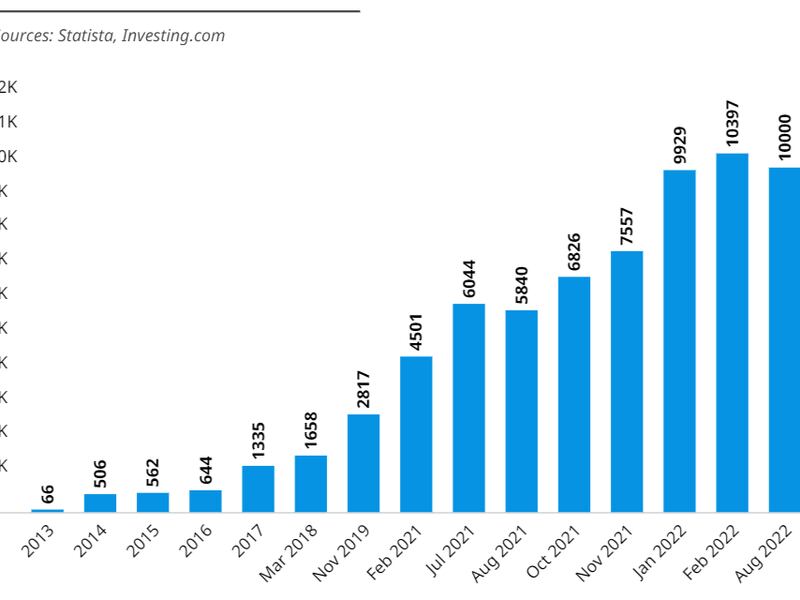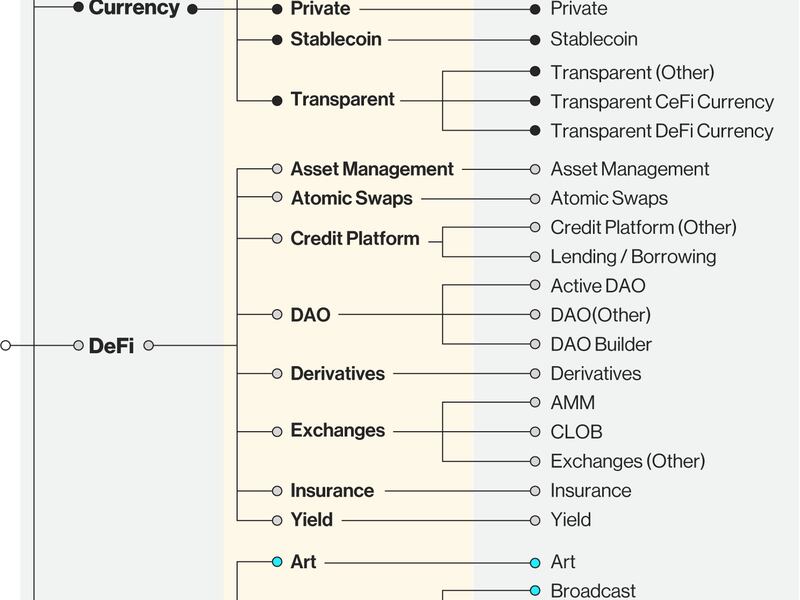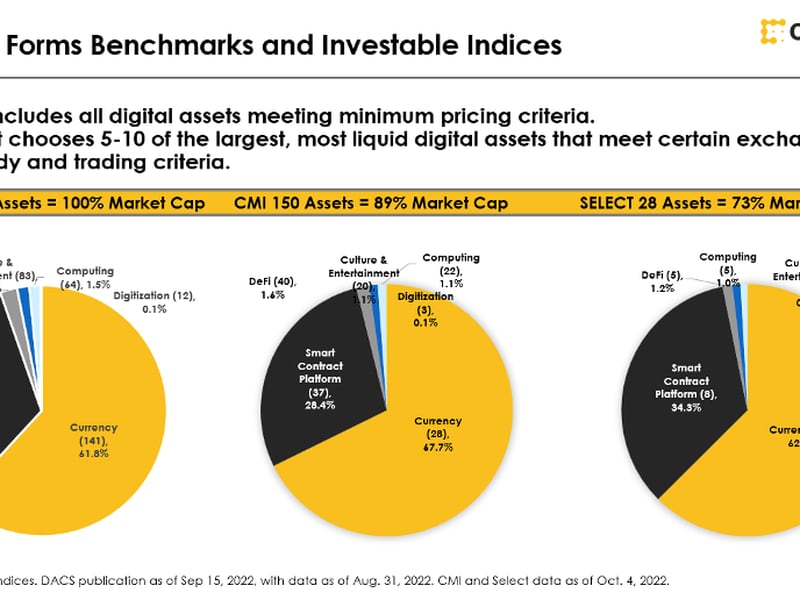How Digital Assets Get Into Investable Indices

Since the inception of bitcoin in 2008, the digital asset industry has been growing at a rapid pace, accelerating the emergence of the new digital finance economy. This booming new asset class has resulted in the development of new investment vehicles and opportunities with thousands of different projects, use cases and applications using blockchain technology to transform industry infrastructure. While there is a wide range of estimates on the number of existing cryptocurrencies, the growth is clear. As of Oct. 26, 2022, coinmarketcap.com, coingecko.com and investing.com listed 21,522, 13,260, and 9,409 coins, respectively.
Number of Cryptocurrencies Worldwide From 2013 to August 2022

This extraordinary growth has created a commensurate amount of complexity. To help investors better understand the digital asset space, CoinDesk Indices introduced the Digital Asset Classification Standard (DACS). DACS provides the market with a reliable structure and transparency to help classify and simplify the industries inside the asset class. DACS also serves as the fundamental framework and foundation that supports CoinDesk Market Index (CMI) benchmarks for performance measurement and CoinDesk Select Indices for building investment strategies.
This paper covers our process of narrowing the universe of digital assets for investable indices. It outlines how DACS defines and organizes industries for digital asset categorization, then reviews minimum eligibility for inclusion in benchmarks to provide market measurements. It finally describes the stricter criteria for inclusion in investable indices.
CoinDesk Digital Asset Classification Standard (DACS)
Using a classification standard to define markets is not a new concept. The Global Industry Classification Standard (GICS), developed by MSCI and Standard & Poor’s in 1999, has been widely used by equity investors to classify publicly traded companies globally. Research shows GICS explains stock return co-movements within sectors, helping investors determine important drivers for company valuations, identify relative value opportunities by comparing companies in the same sector and develop sector level macro insights to make decisions on asset allocation.
Furthermore, sector indices developed based on GICS have become the backbone of investor allocation, risk and performance-evaluation models. According to a recent Index Industry Association (IIA) benchmark survey, approximately 1.47 million sector- or industry-based indices are calculated daily, which is nearly half of all available equity indices. This truly speaks to the power of GICS to modernize equity investing.
While DACS is unique to digital assets, it serves many of the same functions as classification systems used for traditional asset classes. Among other things, DACS provides the market with a transparent and standardized method to determine sector and industry exposure, facilitate portfolio attribution analysis and help pinpoint investment opportunities.

DACS is designed to define and organize the industries of digital assets to enable each of the top 500 eligible digital assets by market capitalization to be assigned to an industry based on its use case and technology. Then, each industry is assigned to an industry group and each industry group is assigned to a sector. This classification currently results in a three-tiered hierarchy. The industry, industry group and sector definitions in the DACS glossary provide a common language for the industry. The definitions set the framework for the standard taxonomy of digital assets.
To be included in DACS, digital assets must be covered by CoinMarketCap.com and ranked in the top 500 digital assets. However, any asset with significantly contested or disputed circulating supply data, lack of transparency in the form of public documentation and white papers, or assets that are no longer in operation or have been restructured will be excluded from DACS. Moreover, assets that are considered a gas token, staked token or wrapped are not currently eligible for inclusion in DACS.
The assignment of an industry to a digital asset is based on the asset’s actual or intended use case or application. This is determined by reviewing available documentation or white papers on the project’s website, its social media channels, on-chain activity, third party audits, peer reviews or other publicly available information.
Once the use case and/or application has been determined, the digital asset will be assigned to the most appropriate Industry, using the definitions in the Glossary. The Industry assignment will be guided by identifying the dominant use case or application of the digital asset and identifying digital assets with similar use cases or applications.
Industry definitions as defined in the Glossary may require modifications because they are intended to account for new use cases or applications not previously considered. The definitions should reflect accurately current terminology in the digital asset space and provide clarifications, increase transparency and improve consistency.
The DACS structure will also be modified as needed to capture the evolution of the digital asset market. These changes may include expanding or collapsing the number of sectors, industry groups or industries. The changes might also involve migrating industry groups or industries within the DACS hierarchy as well as material changes to existing definitions used to classify a digital asset.
Any modification to the DACS structure will be announced publicly with appropriate lead time prior to implementation. These changes are generally determined based on market input and feedback. To facilitate these discussions, CoinDesk Indices may issue public consultations to provide analysis and proposals seeking feedback to help inform its final decision. Additionally, the DACS Advisory Council is composed of key digital asset market participants and other influential individuals within the digital asset space to assist CoinDesk Indices in determining potential changes to the DACS structure.
Lastly, DACS is governed by the DACS Committee, which is responsible for the oversight of the DACS structure, definitions, and classifications. Material changes to the DACS structure and/or DACS Methodology must be reviewed and approved by the DACS Committee prior to implementation.
Although DACS serves a vital role in defining, organizing and categorizing the industries and digital assets based on their use cases and technology to provide a common language and standard taxonomy to classify tokens, it is unable to measure markets to support investment strategy. Therefore, the CoinDesk Market Index (CMI) Family was developed to enable performance measurement of the broad digital asset market and its segments.
CoinDesk Market Index (CMI) Family
Benchmark indices are often the most underrated yet most powerful drivers of returns. This is because indices are used throughout the investment process at nearly every critical decision-making stage. First, indices are often used as the asset class proxy in asset allocation models to decide how much to allocate for a given set of goals. Then, benchmarks are used to find managers that outperform or are uncorrelated so the money can be put to work. Managers often use the constituents of the benchmark as their starting universe and further use the benchmark sector and constituent weights as the anchor to overweight or underweight positions, or even go short for hedge funds, in their strategies. Beyond the technical data, the industry fundamentals are used in sector- or factor-focused rotation strategies and for peer group valuations. Then, in post-investment analysis, benchmarks help answer the question whether managers did a good job.
The CoinDesk Market Index (CMI) and its subindices are a family of broad-based digital asset indices designed to measure the market capitalization weighted performance of the digital asset market. The family includes indices that reflect sectors defined in DACS.
The CMI Methodology narrows the DACS digital asset universe by requiring minimum pricing, then market cap weighting the eligible assets. There are four major eligibility criteria for assets to be included in the CMI family:
1. Inclusion in the latest DACS report
2. Must be listed on at least two eligible exchanges
3. Must be listed on an Eligible Exchange* for a minimum of 30 days
4. Pricing must be available by a CoinDesk reference price**
The constituents that meet the above four requirements are then weighted by market capitalization. They are reconstituted and rebalanced on a monthly basis. The CMI index family is calculated in real time using reference rates for each asset.
Given that the goal of CMI is to be as broad as possible, it aims to capture all digital assets that meet the Eligibility Criteria including stablecoins and meme coins. It provides a broad representation of the performance of the digital asset market and its segments. Therefore, it may include digital assets that are relatively illiquid or otherwise difficult to access, own, trade or custody. Digital assets that meet all eligibility criteria are included regardless of their designation as a security by a government agency.
Currently, the CMI eligibility criteria narrows the 500 digital assets assigned by DACS to 150 digital assets, covering 89% of the market cap. While CMI serves a solid role in performance measurement for various use cases, it is generally not replicable for tracking products like funds or derivatives. Therefore, the CoinDesk Select Indices were created to deliver investable index strategies.
CoinDesk Select Indices
The innovations in financial products from derivatives to ETFs and now tokenized funds have increased demand for investable indices that serve as the underlying strategies for these tracking products. Although the growth of index strategies has exploded in traditional and alternative asset classes, the digital asset indices that are intended to underpin investment products are relatively new due to specific requirements by investors. Therefore, the CoinDesk Select Indices are designed to measure the performance of some of the largest and most liquid digital assets classified in DACS that meet certain trading and custody requirements.
Generally, the CoinDesk Select Indices*** include five to 10 assets that meet stricter eligibility criteria than the simple availability of pricing and market cap data. There are four major eligibility criteria to determine the Select Index Universe:
1. The digital asset must be ranked in the top 200 in the latest published DACS report.
2. Custodian services for the digital asset must be available from Coinbase Custody, a division of Coinbase Global Inc., and the digital asset must be accessible by U.S. investors.
3. The digital asset must not be a stablecoin or categorized as a meme coin as determined by CDI.
4. The digital asset must have been listed on an Eligible Exchange for a minimum of 30 days.
Next, the top 20 digital assets from the Index Universe are ranked by market cap to determine Selection Universe before the constituents are chosen. Five to 10 digital assets are included from the Selection Universe by their median daily value traded and median market cap, where higher thresholds are required for non-constituents than for incumbent constituents. The median daily value traded and median market cap values need to be greater than or equal to 1.2 times the 30-day median for non-constituents, and constituents need to have greater than or equal to the 30-day median for constituents. Non-constituents must be on Watchlist by passing all eligibility criteria for one quarter ahead of the quarter a digital asset may be added to the index.
While the selected assets may be weighted in various ways including by market cap, equally weighted or risk weighted, the market cap weighted results generally maintain the sector exposures in proportion to the broad set of digital assets. The process in narrowing the universe from 500 digital assets assigned in DACS to currently 150 digital assets in the CoinDesk Market Index (CMI) and further to the current set of 28 assets in the Select Sectors enables investors to access the market beta with relatively few assets. Because the digital asset market is still emerging and highly concentrated, the set of fewer assets covers most of the market cap with just over 5% (28 digital assets) of assets covering nearly 75% of the entire market cap.

Conclusion
The incredible growth in digital assets beyond bitcoin has created numerous investment opportunities across the new economy. However, finding those investment opportunities in the sea of digital assets requires a deep understanding of use cases and technology combined with expertise about Investability. Narrowing the digital asset universe by pricing availability, liquidity, exchange and custodial requirements is critical to determine which digital assets are appropriate for quality investors. The methodical practices developed to organize the digital asset universe and select the largest and most liquid constituents representing the asset class and its sectors may help investors throughout their investment processes.
Footnotes:
* Eligible Exchanges listed in the CoinDesk Digital Asset Indices Policy Methodology, Binance.US, BitFlyer, Bitstamp, Bittrex, Coinbase Pro, ErisX, FTX.US, Gemini, itBit, Kraken, LMAX Digital, Okcoin.
** Real-time “spot” reference price rates for constituent digital assets are calculated approximately every 5 seconds by CDI using a volume weighted average price (VWAP) across at least two contributing exchanges over the prior 60 minutes.
*** The CoinDesk Select Indices currently include the CoinDesk Large Cap Select Index, CoinDesk Industry Group Select Equal Weight Index, CoinDesk Select Sector Index and CoinDesk Select Industry Group Index. All methodologies are posted at https://www.coindesk.com/indices/governance/.








